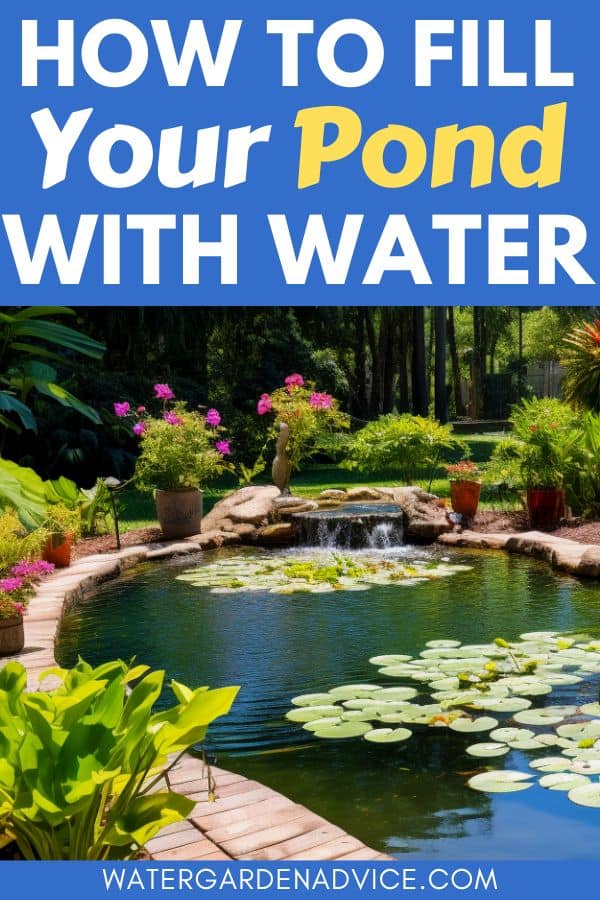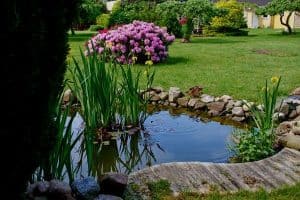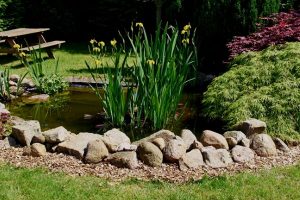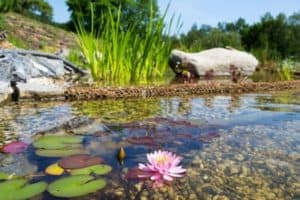Filling a pond with water may seem like a simple and straightforward task, but there are a few things you need to consider to ensure your pond is filled properly.
Whether you’ve just built a new pond, need to top off an evaporating water supply, or simply want to maintain healthy pond water levels, I’ve got you covered with some helpful tips.
This post contains affiliate links. Please read the disclosure for more info.
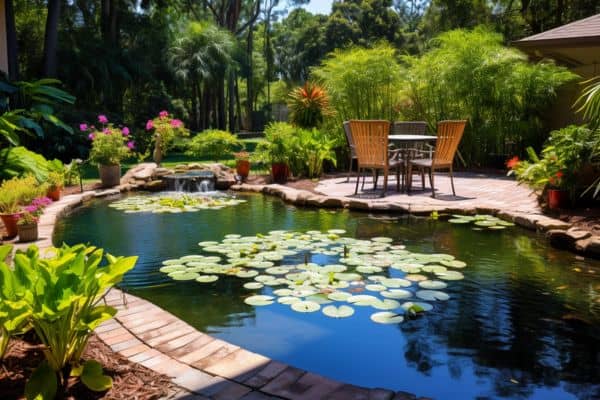
HOW TO FILL YOUR POND WITH WATER
Choosing a Water Source
When filling your pond, selecting the right water source is crucial to maintain a healthy ecosystem. Depending on your location and preferences, there are several options to consider.
Tap Water
Tap water is a common choice for filling a pond due to its accessibility, but you should be aware of its potential drawbacks.
Tap water often contains chlorine, which can harm your pond’s aquatic life, so you’ll need to use a dechlorinator to remove the chlorine from the water.
Alternatively, allow the tap water to sit in a separate container for 24 hours before adding it to your pond, and this will allow the chlorine to evaporate naturally.
Well Water
If you have access to a well, it can be an excellent source of water for your pond.
Well water usually comes from groundwater and springs, making it less likely to contain harmful chemicals, but it’s crucial to analyze the water quality, as contaminants might be present.
A filtration system can help to remove unwanted substances and maintain a balanced pond environment.
Rainwater
Collecting rainwater using a water tank or rain barrel is an eco-friendly option.
Rainwater is free from chemicals, so it helps to promote a natural pond ecosystem.
When collecting rainwater, capture the runoff and filter it through fine mesh netting to remove debris and impurities before transferring the water to your pond.
Stream Water
Utilizing water from streams and other surface runoff sources can be an ideal choice if your pond is connected to a natural body of water, but it’s essential to obtain any necessary permits before redirecting stream water to your pond.
If you’re using stream water you’ll also need to be cautious of potential contamination from agricultural or industrial runoff, and implement a filtration system if needed.
Using a Water Provider
If you don’t have access to a suitable water source or lack the equipment to filter or transport the water, consider hiring a water provider.
They can supply water in bulk and ensure it’s safe for your pond’s ecosystem.
Prepping the Pond for Filling
Before you start filling your pond with water, it’s important to take some preparatory steps.
This will ensure that your pond remains free of problems once it’s filled.
Pond Liner Preparation
Pond liners provide a barrier between the water and the soil to prevent water loss through seepage.
You can choose from various materials like rubber or plastic, but it’s essential to make sure the liner is durable and puncture-resistant. To prepare the liner:
- Remove any sharp objects from the area where you’ll install the liner.
- Lay down a layer of sand or soil about 2 to 3 inches (5 to 7 cm) thick to provide a cushion for the liner. This helps prevent punctures and ensures a smooth surface.
- Carefully unroll the pond liner, making sure it covers the entire pond area and its sides. Leave some extra material around the edges for anchoring.
Check for Leaks
Once you’ve prepped the pond liner, it’s vital to check for leaks. A leaking pond can lead to significant water loss and a potential failure of your pond ecosystem. To do this:
- Fill the pond with a small amount of water, just enough to cover the liner.
- Observe the water level for at least 24 hours to see if there’s any noticeable drop.
- If the water level drops, carefully inspect the liner for any punctures or tears and repair them with a pond liner patch kit.
Assessing the Pond’s Size and Purpose
Water Level
Maintaining an appropriate water level in your pond is vital for the pond’s health and maintenance.
The water level is influenced by factors such as rainfall, evaporation, and inflow/outflow rates. To ensure a proper water level:
- Monitor your pond’s water level regularly: Keep an eye on the water level, especially during periods of heavy rain and dry spells. You can adjust the water inflow or outflow accordingly.
- Create stable pond edges: A well-structured pond edge, from a pond liner or constructed banks, will minimize water loss through seepage and help maintain the desired water levels.
- Understand the water requirements of the pond’s inhabitants: Fish and plants in your pond have specific water level requirements. For example, koi ponds need to have a water depth of at least 3 feet (90 cm) to accommodate the growth of the fish.
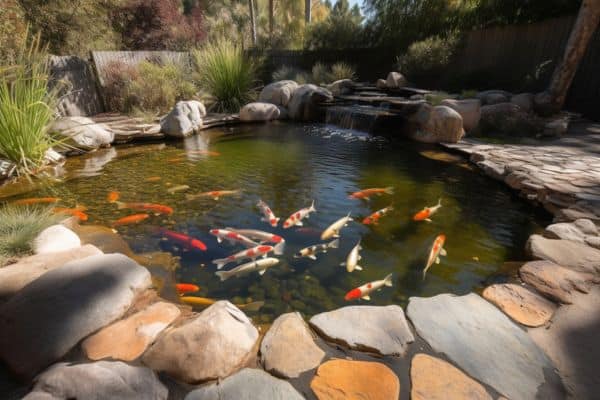
Treating the Pond Water
Water Conditioner and Dechlorinators
When using tap or hose water to fill your pond, it’s crucial to treat the water with a water conditioner or dechlorinator. These products help to neutralize chlorine and other harmful substances found in tap water, making it safe for fish and beneficial bacteria.
Maintaining Water pH Levels
Maintaining the right water pH levels in your pond is essential for the health of your fish, plants, and beneficial bacteria.
A balanced pH helps prevent issues like algae overgrowth and keeps oxygen levels stable. To maintain the proper pH balance, you’ll need to:
- Test the water regularly: Use a water testing kit to monitor the pH levels in your pond. Aim for a pH of around 7, which is considered neutral and safe for most pond inhabitants.
- Add buffering agents: If your water tests too acidic (low pH) or alkaline (high pH), use buffering agents like pH adjusters to help balance the levels.
- Increase oxygen: Consider adding an aeration device like a water fountain, bubbler or waterfall to boost oxygen levels in the pond. Oxygen helps good bacteria break down ammonia and nitrites, which can affect pH levels.
- Control algae: Algae growth can lead to fluctuations in pH levels. Use a UV clarifier to keep algae in check.
How Long Does it Take to Fill a Pond?
A small garden pond may fill quickly with just a few days of heavy rain, especially if it’s located in a low spot in the garden where the water can run off into the pond.
If you’re relying on natural rainfall, the time it takes can be unpredictable.
However, if you have access to a water pump with a consistent rate, you can estimate how long it will take to fill the pond. The more water your pump can supply per hour, the faster your pond will fill up.
Apart from the size and water source, the design and construction of your pond can also influence the filling time.
A pond with a good liner will help retain water more effectively than an unlined pond.
Well-compacted clay soil will also ensure the pond holds water, minimizing the chances of seepage.
To get a better idea of how long it will take to fill your specific pond, you can use calculation tools based on your pond’s dimensions and available water source.
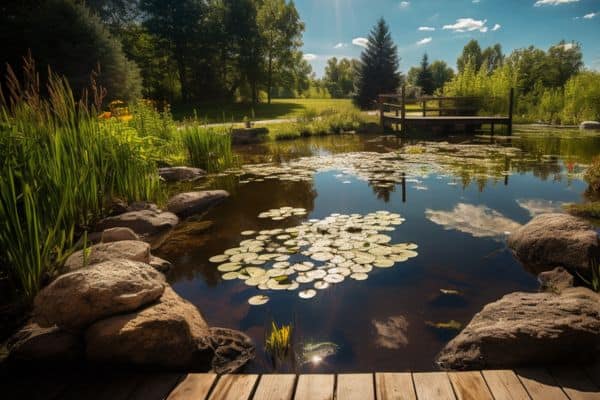
Topping Up the Pond Water
Don’t replace all of the pond water at once, aim to replace about 10% of the water every week.
This gradual process allows the pond’s ecosystem to adjust to the new water without causing too much stress on its inhabitants.
Keep in mind that a newly filled pond will initially have no bacteria. Aerobic bacteria play a critical role in converting ammonia to nitrites and then into nitrates.
Gradually introduce these helpful bacteria by adding water from a mature pond or natural beneficial bacteria. This will help to establish a stable ecological balance in your pond. [1]
How Long to Wait Before Adding Fish?
It’s exciting to see your pond filling up with water, and you might be eager to add fish right away.
However, it’s essential to wait for the right time to ensure a healthy and thriving aquatic environment.
To ensure that your fish don’t suffer from shock, wait until the pond water temperature is at least 60°F (15°C) before introducing them.
The ideal time to add new fish to a pond is during late spring or early summer, when the temperature is warm but not too hot.
After purchasing your fish, place the bag on the surface of the pond in the shade and let it sit for about 30 minutes to allow the water in the bag to adjust to the same temperature as the pond.
This will help your fish acclimate to their new environment and reduce the risk of stress or illness.
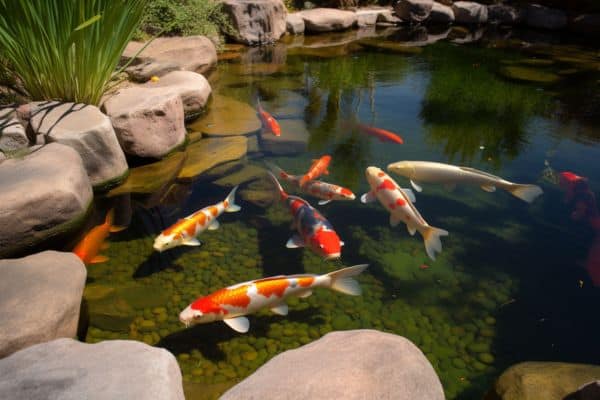
RELATED ARTICLES
- How to Keep Pond Water Cool in Summer
- How To Stop Your Pond Overflowing
- How to Reduce Pond Water Evaporation
- Can You Water Plants with Pond Water?
- How To Make Your Pond Water Clear Blue
So there are my tips for filling up a pond with water.
By following the steps outlined in this post you can create a beautiful backyard pond that you can enjoy for years to come.
Are you on Pinterest? I have boards dedicated to Garden Ponds and Pond Maintenance that you may find interesting.
